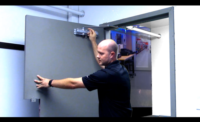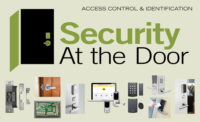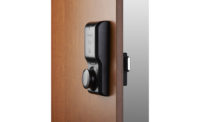There has been a big shift in the security market in the past few years — both for commercial and residential systems. IP, PoE, intelligence at the edge, cloud and mobile credentials all require new knowledge on the part of the installer. But the hardware that goes with these technologies is changing along with them, and as locking hardware gets “smart,” security dealers and integrators have more opportunities than ever, provided they have the education to take advantage of it.
“One of the biggest trends in security locks and door hardware is thinking beyond the traditional opening,” says Stacy Deveraux, marketing and product management, ASSA ABLOY Electromechanical Specialties, Phoenix, Ariz. “Manufacturers, dealers and integrators are seeing that more than just doors need to be secured — openings of all sizes from the smallest of drawers to the largest of entryways and everything in between.”
Bryan Sanderford, national sales manager, Dortronics Systems Inc., Sag Harbor, N.Y., says security locks and hardware have followed the larger trends in the security market. “The professional security industry continues to shift from a hardware-driven to a software-driven market. Most physical security systems today employ some level of IP integration with software control, whether via an access control or video management system,” he says.
This is true for user demand, as well. “With the advent of self-service kiosks that can duplicate many types of keys or clone unsecure proximity and Mifare credentials without verifying that the person is actually authorized to have a duplicate made, there is a greater awareness from end users of the need to secure a facility both mechanically by deploying restricted keys, and electronically by upgrading existing proximity readers and credentials,” says David Cronk, PSP CRL, director of product development, General Lock Division, Anixter, Glenview, Ill. “Many are adding security measures at the perimeter of the building and inside the building to segregate visitors and employees or students. There’s also increased demand to be able to lock down and secure critical areas from active shooters.”
As security locks and hardware continue to evolve to meet the changing needs of end users, there are a few trends security dealers and integrators should be aware of. SDM asked several manufacturers and distributors what trends they anticipate for 2019 and beyond, as well as what new challenges installers should watch for.
The Trends at a Glace
- The desire to secure openings of all sizes — from the smallest of drawers to the largest of entryways.
- Integration with IP systems/software control.
- Locking down and securing critical areas from active shooters.
- Use of more secure credentials.
- Greater usage of low-powered locks and intelligence at the edge.
- Mobile credentials on the rise.
- Emphasis on the cyber security of access control technology for openings.
- Increased educational offerings on technologies, codes and regulations.
What’s Hot For 2019
As users increasingly become aware of issues such as cyber security, Cronk anticipates the continued disfavor around using 123 KHz proximity and some legacy smart cards in favor of more secure credentials such as Mifare Plus, Mifare Desfire EV2 and HID Seos credentials.
Integrated all-in-one locks will continue their rise in popularity, as will locks that require less power, Cronk adds. “Lower power usage locks are being required much more as IP controllers that are powered by PoE are being used in a distributed architecture at or above the door. Centralized access control architecture is being used less.”
Deveraux echoes the intelligent lock trend. “There is a growing addition of intelligence at the lock. No longer are locks and door hardware about who gets into and out of an opening. They’re helping detail what’s happening at the opening and the information that can be obtained. In a healthcare setting, for example, who last accessed pharmaceuticals at the nurse’s station? How can data collected from the opening be analyzed to improve efficiencies or the patient experience?
“More and more we are seeing the evolution to wireless and intelligence-based key systems. For example, form factors that secure cabinets, drawers and doors with one credential, or key systems that offer the advantages of offline at an affordable price point,” Deveraux describes.
Intelligent locks are making inroads in the residential space as well, says Nick English, North American sales manager for residential access solutions, Kwikset, Lake Forest, Calif. “When hooked up to a smart home hub, they can arguably become the centerpiece of a connected home,” he says of the lock’s growing place in the home. Because of this, there are a few central features that are critically important in the residential setting that are different from commercial. “Without question, battery life is number one in lock selection. The second most important area is minimal interior size…. Design is another critical factor; and of course value plays a part as well.”
While all of these are not necessarily new factors, one thing is changing, English adds. “One of the areas that has received a great deal of attention — and deservedly so — is the digital security of smart locks. More people are concerned about the ‘hackability’ of connected devices, including smart locks. It’s a reasonable concern, and for the most part the major lock companies have done a credible job of ensuring the digital security of their offerings.”
Make Way for Mobile
Of all the changes hitting the security lock market, mobile credentials might be the most recent — and influential. If you have not started seeing demand for mobile credentials from customers, according to the experts it is just a matter of time.
“Within the next two years 20 percent of all access credentials will be mobile access,” says Anixter’s David Cronk. “Secure credentials on a phone that will require authorization to be used will become more commonplace.”
Access Hardware Supply’s Bill Smoyer says mobile credentials like those from HID and Allegion are becoming more a part of the mobile phone and are particularly popular on college campuses.
ASSA ABLOY’s Stacy Deveraux agrees. “Mobile credentials are almost becoming an expectation in many spaces that our industry serves…. We live in an increasingly mobile and fast-paced world. We want information and we want it now. And we want it to make our lives easier. Virtually all of us depend on our smartphone. Why should access control be any different?”
Deveraux adds that the mobile trend goes beyond just credentials. “Mobile advances will not only impact the products we develop but also how our industry interacts on all levels: The path to purchase, live chat, virtual troubleshooting guides; and personalized features based on AI and data analytics.”
New Challenges & Solutions
The pace of innovation in the security industry can be breathtaking and that is true on the locks and hardware side as well, particularly for integrated locks. Many are now being offered with mobile credential options, for example (see “Make Way for Mobile” on page 52), and there are more options than ever on types of openings that can potentially be secured. Some of these advancements can add challenges for the security dealer and installer, but manufacturers are also stepping up with new advancements to make things simpler, as well as more opportunities for education.
“Some of the new challenges dealers and integrators are facing include leveraging secure credentials,” Cronk says. “There is a lack of understanding of the vulnerabilities of unsecure credentials. Also integrated, all-in-one door hardware requires certification from the manufacturers; IP controllers are moving to PoE power and having limited lock power outputs; and technical skillsets are needed on the integrator side when it comes to methods and systems to specify and install facility lockdown solutions.”
Bill Smoyer, national sales manager, Access Hardware Supply, San Leandro, Calif., adds, “Dealers and end users are tasked with interfacing with existing door hardware on retrofit projects. But there are many manufacturers making products to assist in these challenges.” For example, smart-enabled locks allow for reduced wire runs to the door and reduced labor for deployment, he says. Smart padlocks can allow facilities to replace the brass key and have an audit trail.
Another example, from Kwikset, is Kwikset Convert, which provides installers the ability to convert mechanical locks into smart locks, English says.
“The rate of innovation, advances in technology and amount of information available to all of us can be overwhelming,” Deveraux says. “Codes and regulations based on municipality, region, vertical market and project add [even more] layers of complexity.”
David Price, marketing manager, Camden Door Controls, Mississauga, Toronto, Canada, seconds the challenges that codes and regulations pose for dealers. “They are looking to us for more assistance with identification of correct locking hardware for each application to ensure compliance to codes and regulations.”
Education is a very important piece of the equation, Sanderford adds. “The need for continued education is critical for physical security dealers/installers to keep pace with new technologies and products. This is especially true with regards to software-driven systems and products that offer greater levels of programmability. Dealers and installers should look to their manufacturing partners for education. To this end, Dortronics launched a very aggressive lunch and learn program in 2018 to provide resellers with the latest information and certification credits.”
Deveraux agrees. “It is our job as a manufacturer to simplify doing business with us as much as possible. The more complicated the solution becomes, the more important it becomes for us to simplify that information for the customer. We’re working hard to make it as digestible as possible with tools and resources such as hands-on training, live chat, training videos and a customer service app. We must help create the tools to assist our customers in choosing the correct products for their projects to help them gain confidence in selecting the right solutions.”
More Online
For more information about security locks and hardware, visit SDM’s website where you’ll find the following articles.
“How Distributors Can Help You Sell More Security Locks & Hardware”
www.SDMmag.com/how-distributors-can-help-you-sell-more-security-locks
“How Can Low-Powered Locks Benefit You?”
www.SDMmag.com/how-can-low-powered-locks-benefit-you
“3 Trends Poised to Impact Door Access”










